Exterior of the U.S. Holocaust Memorial Museum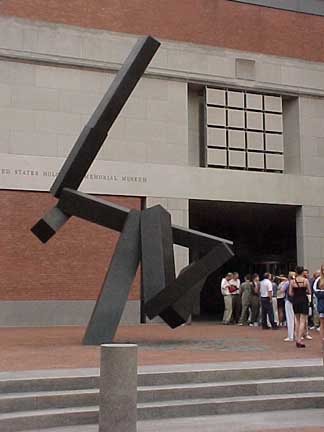 In April 2000, I visited the US Holocaust Memorial Museum twice on two successive days. The Museum is located in the heart of our nation's capital in Washington, DC, just off the Capitol Mall. The photo above shows the entrance on 15th Street. The main entrance is on the other side of the building on 14th Street. The Capitol Mall is a long narrow park, which extends two and a half miles from the Capitol building to the Lincoln Memorial at the west end. Lined up along both sides of the Mall are our national museums of American history, art and science. The midway point of the Mall is marked by the Washington monument, which stands like a beacon in a field surrounded by American flags. The street that crosses the Mall in front of the Washington Monument is 15th street, which runs north and south, and goes past the east side of the iron fence surrounding the White House grounds. The US Holocaust Memorial Museum is about a mile from the Capitol and half a mile from the White House. It was built on Federal land with funds donated by private citizens. At the Washington monument, 15th street suddenly changes to Raoul Wallenberg Place. This section of 15th street was renamed in 1985 in honor of the diplomat who helped thousands of Hungarian Jews escape deportation to the death camp at Auschwitz-Birkenau in what is now Poland, by providing them with papers that said they intended to emigrate to Sweden after the war. Among the survivors saved by Wallenberg was Senator Tom Lantos, who emigrated to America after the liberation of Europe from the Fascists. 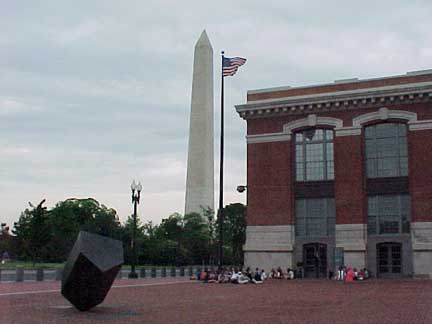 On the corner of Raoul Wallenberg Place and Independence Avenue (the street which forms the southern border of the park-like Mall) stands an old traditional style red brick building, now called the Ross Center, which houses the administrative offices of the museum and the museum cafe. The Ross center is named after Eric F. Ross whose parents, Albert and Regina Rosenberg, died in Auschwitz in 1942. The back of the Ross Center building is on Independence Avenue while the entrance faces a brick-paved courtyard in front of the 15th street entrance to the USHMM, which is set back from the street. From the courtyard, there is a perfect view of the Washington Monument, as seen in the photograph above. The Jefferson Memorial is southwest of the museum, across the nearby Tidal Basin, but the view of it is blocked by the trees. Across the street from the museum is a park with an open field where a crowd of people congregated under a sea of umbrellas on April 22, 1993 when the museum first opened on a miserable cold and rainy day. 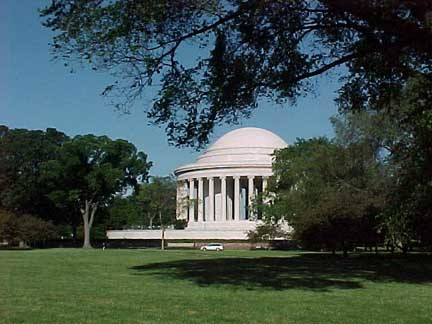 The massive museum building, designed by Jewish architect James Ingo Freed, was built on a 1.9 acre site where another building was torn down. It took 8 years to complete, at a cost of $168 million. At the ground-breaking ceremony on October 16, 1985, soil from some of the Nazi concentration camps in Europe was mixed with the soil at the site. The photograph below shows the 14th street entrance to the museum with a traditional red-brick building next to it at the corner of 14th Street and Independence Avenue. 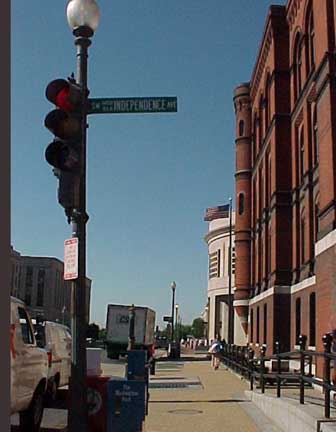 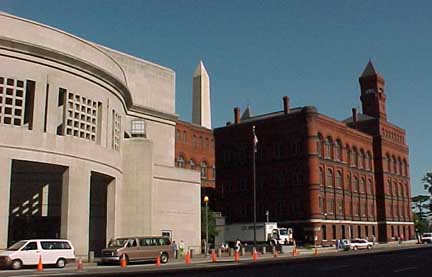 The photograph above shows the 14th Street entrance on the east side of the museum on the left, and the red brick building which stands next to the Ross center on Independence Avenue on the right. In the center of the photo, you can see the Washington Monument, which is just behind the Ross Center. The brick courtyard in front of the west side entrance to the USHMM, shown in the photo below, is named Eisenhower Plaza in honor of General Dwight D. Eisenhower, the Supreme Commander of the Allied forces in Europe, who commanded the invasion on the beaches of Normandy, which subsequently led to the liberation of the Jews from the Nazi concentration camps in Germany. 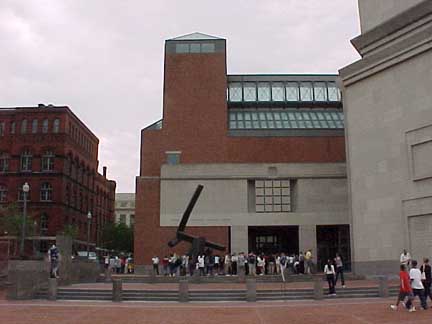 The photo above shows the facade of the Museum building, which faces Eisenhower Plaza. It has several features which suggest places associated with the Holocaust. Sticking up on the left side of the building is what looks like the tower on top of the red brick gatehouse building at Birkenau, the infamous death camp where the Jews were gassed. There are actually four of these tower-like rooms on the north side of the building; on the first floor of the Museum, these rooms contain the Daniel's Story exhibit. To the right of the tower, as shown in the photo above, is a glass enclosed walkway which looks somewhat like the open wooden walkways which were put over some of the streets of the Warsaw and Lodz ghettos in Poland so that non-Jews could pass through the ghetto on the streetcar, or walk on the street below without having to come in contact with the Jews. There are two more glass walkways on the west side of the building on the third and second floors. The Nazis initially isolated the Polish Jews in walled ghettos because they believed that the Jews were carriers of contagious diseases. There are three other glass walkways which cross the top of the building, but they appear to be merely part of the design and not functional. These walkways connect the two sides of the building which are separated by a central atrium that is four stories high and covered by a skylight. From these walkways, visitors can look down below at the main floor, called the Hall of Witness. The building has five floors above ground and a basement below; the basement level is called the Concourse. A two-part modern sculpture entitled Loss and Regeneration, designed by Jewish artist Joel Shapiro, who was born in America in 1941, stands in the courtyard with one section near the sidewalk, and the other part near the door to the museum, as shown in the photo below. 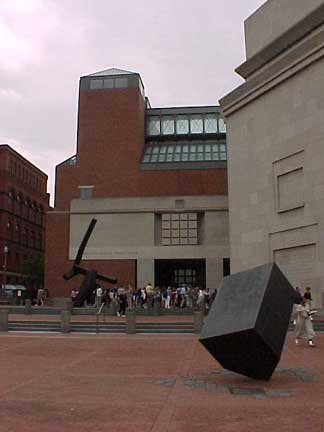 The abstract black figures symbolize the destruction of European Jewry and the regeneration of the Jews; the first section is a house which has been tipped over and is now balanced precariously on the tip of one end of the peaked roof, symbolizing the loss of Jewish homes when the Nazis destroyed the shtetls, as the Jewish villages in Poland were called. A plaque, dedicated to the 1.5 million Jewish children who perished in the Holocaust, is on the ground near the uprooted house; it is engraved with a poem found in 1945, written by a child in the Theresienstadt ghetto in Czechoslovakia (now the Czech Republic). It was probably written in German or Yiddish, but the words on the plaque are in English. Until, after a long, long time I recognized the Holocaust museum instantly as soon as I got my first glimpse of the hexagonal Hall of Remembrance which juts out from the rest of the building like the garage in front of a typical suburban home. The long, narrow museum building is wedged tightly between the Bureau of Engraving and Printing to the south and a red brick government building to the north, as shown in the photo below. 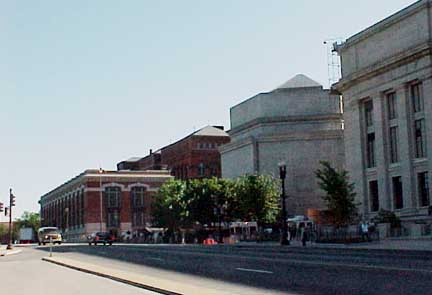 The USHMM is the only modern structure in this neighborhood where all the other buildings feature classic architecture with Greek columns or traditional 19th century details. Neo-Classical architecture was the style favored by the world's most famous amateur architect, Adolf Hitler, so that was not an option for our national Holocaust museum. The result is that the museum seems out of place, like a little Victorian house that is now surrounded by modern office buildings. 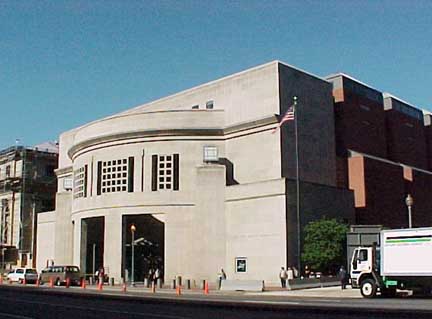 The building material used for the exterior of the museum is a combination of red brick and granite; the brick is on the side of the building that is next to an existing red brick building, and the other side, next to the Bureau of Engraving and Printing, is made of granite blocks. The front entrance on 14th Street, shown in the photo above, is granite. The pattern of the bricks on the towers, shown on the right side of the building in the photo above, resembles the red brick buildings at the Auschwitz-Birkenau concentration camp in Poland and also the brick wall of the Warsaw ghetto in Poland. Inside the museum, there is a reproduction of the last remaining section of the ghetto wall at 55 Sienna Street in Warsaw, so you can compare the pattern. 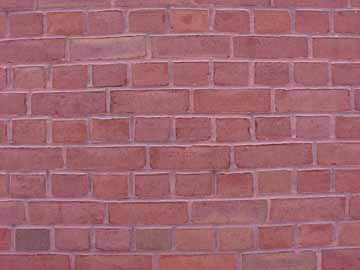 Four sides of the hexagon, which forms the Hall of Remembrance, have a quotation engraved on the outside wall; these quotations are from the speeches of four recent American presidents: Jimmy Carter (who was president when the museum was first conceived), Dwight D. Eisenhower, George Bush, Sr., and Ronald Reagan. Reagan's quote, from a speech made in 1988, is on the south side of the building and hidden away where few people will ever see it. Reagan is not exactly popular with the Jews after his speech at a German cemetery in Bitberg when he said that the German Waffen-SS soldiers who fought in World War II were also victims of the Nazis. Eisenhower's prophetic quote is in the most prominent spot, and it is also the most famous: "The things I saw beggar description...the visual evidence and the verbal testimony of starvation, cruelty and bestiality were so overpowering. I made the visit deliberately, in order to be in a position to give first hand evidence of these things if ever, in the future, there develops a tendency to charge these allegations to propaganda. Ohrdruf April 15, 1945." Ohrdruf was a forced labor camp that was a subcamp of the Buchenwald concentration camp. It had been abandoned by the Nazis as their soldiers retreated in the last days of the war, and it was the first camp, that still had prisoners inside, to be discovered by the American soldiers. Previously, American soldiers had come upon the totally abandoned Natzweiler-Struthof camp in Alsace, which is now in France, but was part of Germany back then. Ohrdruf was the only camp visited by Eisenhower; he saw it on April 12, 1945 (the day that Roosevelt died) in the company of General George Patton and General Omar Bradley. He wrote these words in a letter three days later. Out of concern that Americans back home would not believe the horrors of the camps, with the hundreds of emaciated bodies of prisoners who had died of typhus, Eisenhower ordered that the bodies be left out for weeks and as many soldiers as possible be brought to the camps to witness the tragedy. A huge picture of American soldiers viewing the burned corpses of dead inmates at the Ohrdruf camp is the first thing you see when you step out of the elevator on the fourth floor to begin the tour of the permanent exhibit. The bodies were routinely burned in all the Nazi camps in an attempt to stop the spread of disease. On the outside walls of the hexagon, above the panels where the quotations are engraved, are squares that look like windows that have been closed up. The only windows in this part of the building are thin vertical cracks covered with glass at each of the four corners. The brick section of the building has no windows either. Once you are inside the building, you are closed off from the outside world, just like the Jews in the ghettos and the concentration camps. The front of the building is actually on 14th Street, a very busy, divided two-way thoroughfare. That is where the main entrance is located. Directly across from the museum building on 14th street is a classic building with Greek columns that belongs to the U.S. Department of Agriculture. Hotdog vendors set up their stands every day at lunchtime in front of the Agriculture building or in front of the building next to the museum. There is no food available in the museum, but there is a cafe in the Ross Center. Kosher food is readily available, both on the street and in the cafe. The entrance from the Eisenhower Plaza on the 15th street side (Raoul Wallenberg Place) is reserved for registered groups, but the guards allow anyone to enter there, although the leaders of the school groups try to chase people away. I used this entrance on the second day after I was more familiar with the layout of the museum. At both entrances, there are X-ray machines like those at the airport. Visitors may carry backpacks or cameras into the museum, but photography is only allowed in the Hall of Remembrance. The line for tickets forms on the north side of the building where there are benches and shade trees for the comfort of those who must wait from early in the morning until the museum opens at 10 a.m. The space here is very narrow and visitors sitting on the benches are staring at large panels of gray painted steel that look like covered windows; these steel panels separate the tower-like rooms. The whole building looks very intimidating, like a prison from which there is no escape. Interior of the MuseumExhibits in MuseumDaniel's StoryHall of RemembranceIntroductionBack to Index of the MuseumHomeThis page was last updated on September 8, 2009 |